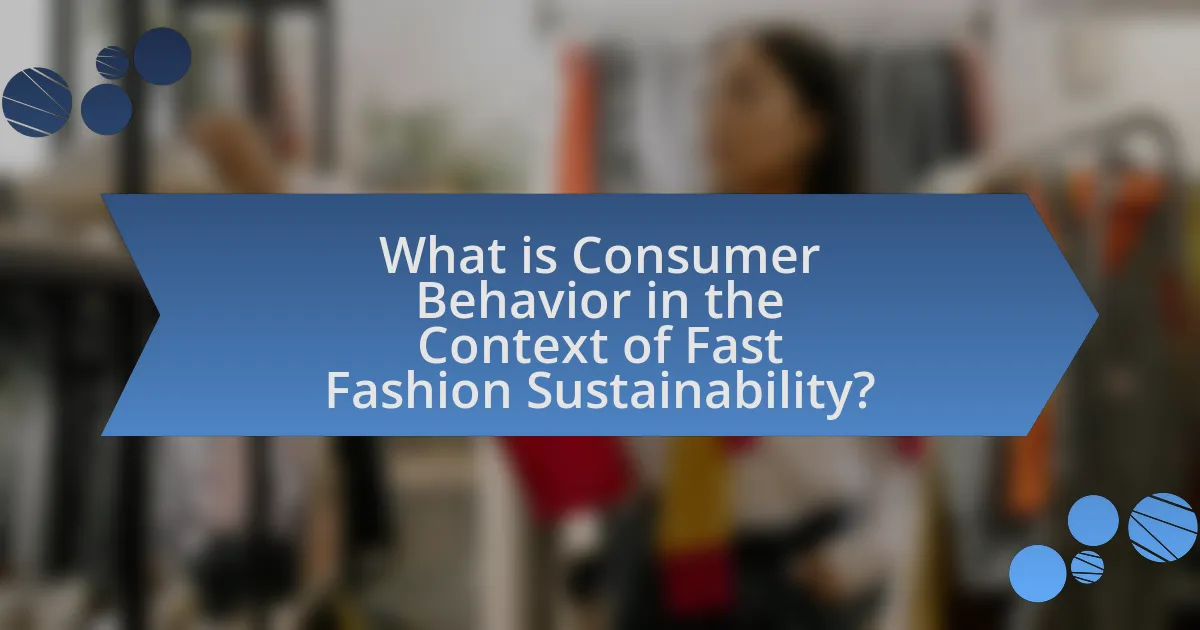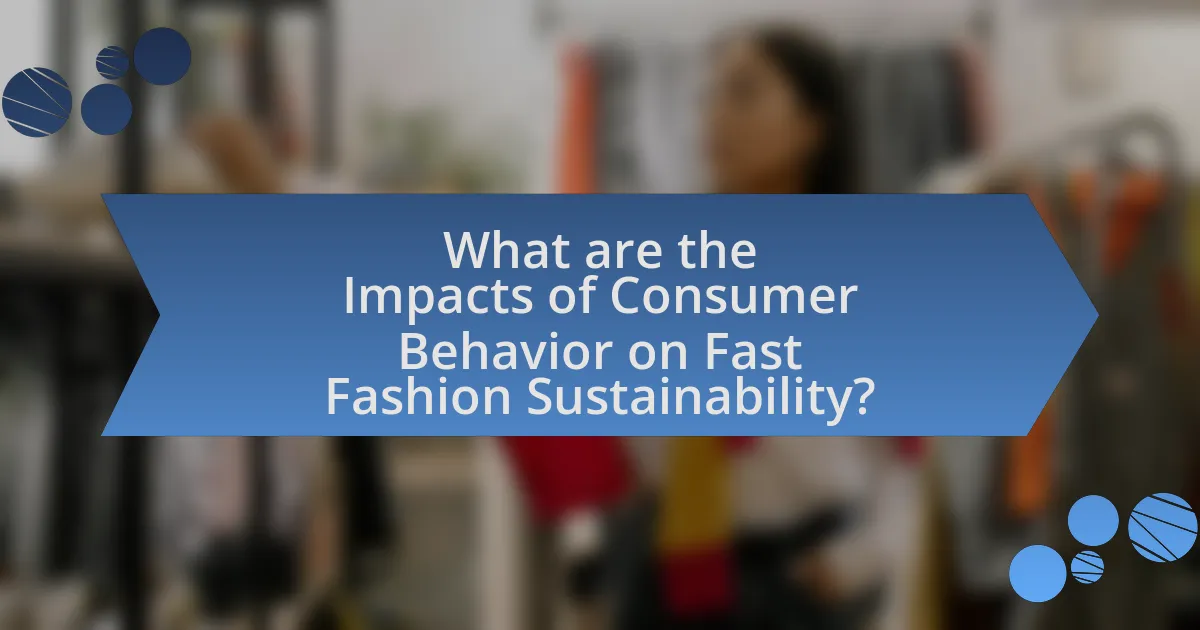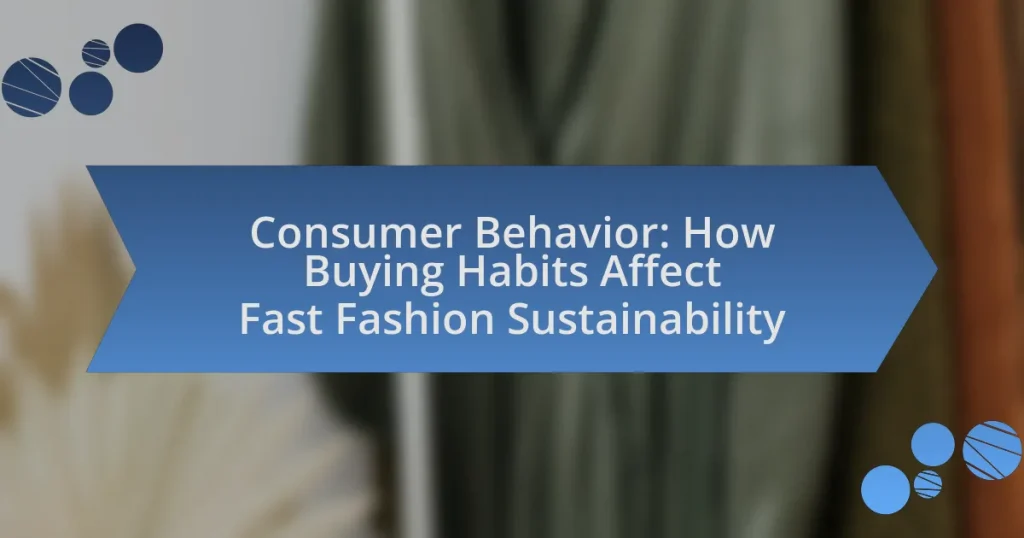Consumer behavior plays a critical role in shaping the sustainability of the fast fashion industry, as purchasing patterns often prioritize affordability and trendiness over environmental and ethical considerations. This article examines how consumer buying habits drive demand for low-cost clothing, leading to increased production, waste, and significant environmental impacts, including high carbon emissions and resource depletion. It also explores the factors influencing consumer decisions, the importance of consumer awareness in promoting sustainable practices, and the social implications of fast fashion consumption. Additionally, the article highlights strategies consumers can adopt to support sustainability, such as choosing ethical brands, engaging in second-hand shopping, and advocating for transparency in the fashion industry.

What is Consumer Behavior in the Context of Fast Fashion Sustainability?
Consumer behavior in the context of fast fashion sustainability refers to the patterns and motivations that drive consumers to purchase fast fashion items, often at the expense of environmental and ethical considerations. This behavior is influenced by factors such as price sensitivity, trend adoption, and the perceived value of clothing, leading to high consumption rates and frequent disposal of garments. Research indicates that consumers prioritize affordability and style over sustainability, with a 2021 survey revealing that 66% of respondents consider price the most important factor when shopping for clothing, while only 25% prioritize sustainability. This trend contributes to the fast fashion industry’s negative impact on the environment, as it encourages overproduction and waste.
How do consumer buying habits influence fast fashion sustainability?
Consumer buying habits significantly influence fast fashion sustainability by driving demand for low-cost, trendy clothing, which leads to increased production and waste. When consumers prioritize fast fashion for its affordability and rapid turnover of styles, brands respond by producing more garments at a faster pace, often using unsustainable materials and practices. According to a report by the Ellen MacArthur Foundation, the fashion industry is responsible for 10% of global carbon emissions, largely due to the high volume of clothing produced to meet consumer demand. Additionally, the average consumer now buys 60% more items of clothing than they did 15 years ago, contributing to a throwaway culture that exacerbates environmental issues. This cycle of consumption and disposal directly undermines sustainability efforts within the fast fashion sector.
What factors drive consumer decisions in fast fashion purchases?
Consumer decisions in fast fashion purchases are primarily driven by factors such as price, trends, and social influence. Price sensitivity is significant, as consumers often seek affordable clothing options, with many fast fashion brands offering items at lower costs compared to traditional retailers. Trends play a crucial role, as the rapid turnover of styles encourages consumers to buy frequently to stay fashionable. Social influence, including peer pressure and the impact of social media, also drives purchasing behavior, as consumers are motivated to align with current fashion trends showcased by influencers and friends. Research indicates that 60% of consumers are influenced by social media when making fashion purchases, highlighting the importance of these factors in driving consumer behavior in the fast fashion industry.
How does consumer awareness impact sustainability in fast fashion?
Consumer awareness significantly impacts sustainability in fast fashion by driving demand for ethical practices and sustainable products. When consumers are informed about the environmental and social consequences of fast fashion, they are more likely to support brands that prioritize sustainability, leading to a shift in industry practices. For instance, a study by the Global Fashion Agenda found that 66% of consumers are willing to pay more for sustainable brands, indicating that awareness can directly influence purchasing decisions. This increased demand encourages companies to adopt sustainable materials and ethical labor practices, ultimately contributing to a more sustainable fashion industry.
Why is understanding consumer behavior crucial for fast fashion brands?
Understanding consumer behavior is crucial for fast fashion brands because it directly influences their marketing strategies, product offerings, and overall business success. Fast fashion brands rely on rapid trend cycles and consumer demand to drive sales; therefore, insights into consumer preferences, purchasing habits, and motivations enable these brands to align their products with market expectations. For instance, a study by McKinsey & Company highlights that 66% of consumers are willing to pay more for sustainable brands, indicating that understanding the shift towards sustainability can significantly impact a brand’s market positioning and profitability. By analyzing consumer behavior, fast fashion brands can adapt to changing trends, optimize inventory management, and enhance customer loyalty, ultimately leading to increased sales and reduced waste in the supply chain.
What role does consumer loyalty play in fast fashion sustainability?
Consumer loyalty significantly enhances fast fashion sustainability by encouraging brands to adopt more ethical practices. When consumers consistently choose brands that prioritize sustainability, these brands are incentivized to maintain and improve their eco-friendly initiatives to retain their loyal customer base. Research indicates that 66% of consumers are willing to pay more for sustainable brands, demonstrating that loyalty can drive demand for sustainable practices. This consumer behavior compels fast fashion companies to innovate and implement sustainable materials and production processes, ultimately contributing to a reduction in environmental impact.
How do marketing strategies affect consumer perceptions of sustainability?
Marketing strategies significantly shape consumer perceptions of sustainability by framing how products are presented and the values associated with them. For instance, brands that emphasize eco-friendly practices and transparent supply chains can enhance consumer trust and loyalty, leading to a more favorable view of their sustainability efforts. Research indicates that 66% of global consumers are willing to pay more for sustainable brands, highlighting the impact of effective marketing on consumer attitudes. Furthermore, campaigns that utilize storytelling to convey a brand’s commitment to sustainability can resonate emotionally with consumers, reinforcing their perception of the brand as responsible and ethical. This connection between marketing strategies and consumer perceptions is crucial in the context of fast fashion, where brands that adopt sustainable messaging can influence buying habits and promote more environmentally conscious choices among consumers.

What are the Impacts of Consumer Behavior on Fast Fashion Sustainability?
Consumer behavior significantly impacts fast fashion sustainability by driving demand for low-cost, trendy clothing, which leads to increased production and waste. The fast fashion industry thrives on consumers’ desire for new styles at affordable prices, resulting in a cycle of overconsumption. According to the Ellen MacArthur Foundation, the fashion industry is responsible for 10% of global carbon emissions and is the second-largest consumer of water, highlighting the environmental consequences of consumer choices. Furthermore, a study published in the Journal of Cleaner Production found that consumers’ preference for quick turnover in fashion contributes to a linear economy, where garments are often discarded after minimal use, exacerbating landfill issues. Thus, consumer behavior directly influences the sustainability challenges faced by the fast fashion sector.
How do buying patterns contribute to environmental issues in fast fashion?
Buying patterns significantly contribute to environmental issues in fast fashion by driving excessive production and consumption of clothing. Consumers frequently purchase low-cost, trendy items, leading to a cycle of rapid turnover and disposal, which results in increased textile waste. According to the Ellen MacArthur Foundation, the fashion industry is responsible for 92 million tons of waste annually, with a significant portion stemming from discarded fast fashion garments. Additionally, the demand for cheap clothing encourages manufacturers to use unsustainable materials and exploit labor, further exacerbating environmental degradation. This consumption behavior not only strains natural resources but also contributes to pollution and carbon emissions, highlighting the detrimental impact of buying patterns on sustainability in the fast fashion sector.
What are the consequences of fast fashion consumption on waste generation?
Fast fashion consumption significantly increases waste generation, contributing to an estimated 92 million tons of textile waste produced globally each year. This waste primarily arises from the rapid production cycles and low-quality materials used in fast fashion, leading to garments being discarded after only a few wears. According to the Ellen MacArthur Foundation, the average consumer buys 60% more clothing than in 2000 but keeps each item for half as long, exacerbating the waste problem. Additionally, only 1% of clothing is recycled into new garments, highlighting the inefficiency of current waste management practices in the fashion industry.
How does the frequency of purchases affect resource depletion?
The frequency of purchases significantly accelerates resource depletion by increasing the demand for raw materials and energy required for production. Each item produced in fast fashion typically involves the extraction of natural resources, such as water, cotton, and fossil fuels, which are finite. For instance, the production of a single cotton t-shirt can require up to 2,700 liters of water, highlighting the substantial environmental impact of frequent buying habits. As consumers purchase more items, the cumulative effect leads to greater resource extraction, contributing to environmental degradation and unsustainable practices in the fashion industry.
What are the social implications of consumer behavior in fast fashion?
Consumer behavior in fast fashion has significant social implications, primarily influencing issues such as labor exploitation, environmental degradation, and the promotion of a throwaway culture. The demand for inexpensive, trendy clothing leads to companies prioritizing profit over ethical labor practices, often resulting in poor working conditions and low wages for garment workers, particularly in developing countries. For instance, a report by the International Labour Organization highlights that many workers in the fast fashion industry earn less than the minimum wage and work in unsafe environments. Additionally, the rapid turnover of fashion trends encourages consumers to discard clothing quickly, contributing to massive textile waste; the Ellen MacArthur Foundation estimates that the equivalent of one garbage truck of textiles is landfilled or incinerated every second. This behavior not only exacerbates environmental issues but also fosters a societal norm where value is placed on quantity over quality, undermining sustainable practices.
How does consumer demand shape labor practices in the fast fashion industry?
Consumer demand significantly influences labor practices in the fast fashion industry by driving brands to prioritize cost-cutting measures to meet consumer expectations for low prices and rapid product turnover. As consumers increasingly seek trendy, affordable clothing, brands often resort to outsourcing production to countries with lax labor regulations, resulting in exploitative working conditions. For instance, a report by the International Labour Organization highlights that many fast fashion workers earn less than the minimum wage and work in unsafe environments, reflecting the industry’s response to consumer demand for cheap and quickly available products. This dynamic creates a cycle where consumer preferences directly impact labor standards, often at the expense of workers’ rights and safety.
What is the relationship between consumer behavior and ethical fashion choices?
Consumer behavior significantly influences ethical fashion choices, as individuals increasingly prioritize sustainability and ethical practices in their purchasing decisions. Research indicates that consumers are more likely to support brands that demonstrate transparency, fair labor practices, and environmentally friendly materials. For instance, a 2021 survey by McKinsey & Company found that 67% of consumers consider sustainability when making fashion purchases, highlighting a shift towards ethical considerations in consumer behavior. This trend reflects a growing awareness of the social and environmental impacts of fast fashion, prompting consumers to seek alternatives that align with their values.

How Can Consumers Influence Sustainable Practices in Fast Fashion?
Consumers can influence sustainable practices in fast fashion by prioritizing eco-friendly brands and making informed purchasing decisions. When consumers choose to buy from companies that demonstrate sustainable practices, such as using organic materials or ethical labor, they signal to the market that there is demand for sustainability. Research indicates that 66% of global consumers are willing to pay more for sustainable brands, highlighting the economic power of consumer choices. Additionally, consumers can advocate for transparency and accountability by supporting initiatives that promote sustainable practices, such as certifications and labeling. This collective consumer behavior can drive fast fashion companies to adopt more sustainable practices to meet market demands.
What strategies can consumers adopt to promote sustainability in fast fashion?
Consumers can promote sustainability in fast fashion by prioritizing second-hand shopping, choosing sustainable brands, and practicing mindful consumption. Second-hand shopping reduces demand for new clothing production, which is responsible for significant environmental impact; for instance, the production of one cotton shirt can require up to 2,700 liters of water. Choosing sustainable brands that utilize eco-friendly materials and ethical labor practices further supports a shift towards responsible fashion. Mindful consumption involves buying only what is necessary and considering the longevity of garments, which can decrease waste and promote a circular economy. These strategies collectively contribute to reducing the environmental footprint of the fast fashion industry.
How can consumers make informed choices when purchasing fast fashion?
Consumers can make informed choices when purchasing fast fashion by researching brands’ sustainability practices, understanding the environmental impact of their purchases, and evaluating the quality and longevity of garments. Research indicates that brands like H&M and Zara have made commitments to sustainability, yet their fast fashion model often leads to significant waste and resource depletion. By utilizing resources such as the Fashion Transparency Index, consumers can assess how transparent brands are about their supply chains and labor practices. Additionally, consumers should consider the lifecycle of clothing, as garments that are durable and timeless reduce the need for frequent replacements, ultimately contributing to more sustainable consumption patterns.
What role does second-hand shopping play in sustainable consumer behavior?
Second-hand shopping significantly contributes to sustainable consumer behavior by reducing waste and minimizing the demand for new production. This practice extends the lifecycle of clothing, thereby decreasing the environmental impact associated with manufacturing, which includes resource extraction, water usage, and carbon emissions. According to a report by the Ellen MacArthur Foundation, extending the life of garments by just nine months can reduce their carbon, water, and waste footprints by 20-30%. Thus, second-hand shopping not only promotes a circular economy but also encourages consumers to make more environmentally conscious choices, ultimately leading to a reduction in the fast fashion industry’s detrimental effects on sustainability.
What are the best practices for consumers to support sustainable fast fashion?
Consumers can support sustainable fast fashion by prioritizing brands that demonstrate ethical practices, such as using eco-friendly materials and ensuring fair labor conditions. Research indicates that 66% of global consumers are willing to pay more for sustainable brands, highlighting the demand for responsible production methods. Additionally, consumers should practice mindful purchasing by buying only what they need, which reduces waste and encourages brands to adopt sustainable practices. Engaging in second-hand shopping and clothing swaps further minimizes environmental impact, as it extends the lifecycle of garments. Lastly, consumers can advocate for transparency in the fashion industry by supporting initiatives that promote sustainability and holding brands accountable for their practices.
How can consumers advocate for transparency in fast fashion brands?
Consumers can advocate for transparency in fast fashion brands by demanding clear information about sourcing, labor practices, and environmental impact. This can be achieved through actions such as participating in campaigns that call for brands to disclose their supply chain details, supporting organizations that promote ethical fashion, and using social media to raise awareness about the importance of transparency. Research indicates that 66% of consumers are willing to pay more for sustainable brands, highlighting the market demand for transparency and ethical practices. By leveraging their purchasing power and vocalizing their expectations, consumers can influence brands to adopt more transparent practices.
What initiatives can consumers participate in to drive change in the industry?
Consumers can participate in initiatives such as sustainable fashion campaigns, clothing swaps, and supporting ethical brands to drive change in the fast fashion industry. By engaging in sustainable fashion campaigns, consumers raise awareness about the environmental and social impacts of fast fashion, influencing brands to adopt more sustainable practices. Clothing swaps allow consumers to extend the life of garments and reduce waste, promoting a circular economy. Supporting ethical brands that prioritize fair labor practices and sustainable materials encourages the industry to shift towards more responsible production methods. According to a 2021 report by McKinsey & Company, consumer demand for sustainable products is rising, with 67% of consumers stating they consider sustainability when making a purchase.
What practical steps can consumers take to reduce their fast fashion impact?
Consumers can reduce their fast fashion impact by adopting sustainable shopping habits. This includes buying fewer, higher-quality garments that last longer, which decreases the frequency of purchases and waste. Additionally, consumers can choose second-hand clothing, which extends the life cycle of garments and reduces demand for new production. Engaging in clothing swaps or renting outfits for special occasions also minimizes the need for new purchases. Furthermore, consumers should prioritize brands that practice ethical manufacturing and sustainability, as this supports responsible production practices. According to a 2021 report by the Ellen MacArthur Foundation, extending the life of clothing by just nine months can reduce carbon, water, and waste footprints by 20-30%.















